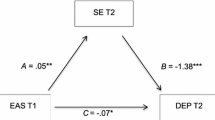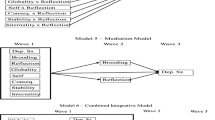Abstract
This study added to understanding of the recovery model of depression in adolescents by testing whether hope mediates the link between enhancing attributional style (EAS) and depression using two independent samples. Study 1 used cross-sectional data from 378 students (51% female) in fifth through seventh grade students. Study 2 used data from 546 (50% female) seventh and eighth grade students at two time points: January and May within the same year. Cross-sectional analyses indicated that EAS indirectly predicted depression. Cross-sectional and prospective analyses indicated that stable attributions, in particular, were associated with lower levels of depression through higher levels of hope. Notably, contrary to expectations, global attributions consistently predicted higher levels of depression. Results suggest that hope mediates the association between attributional stability for positive events and reductions in depression over time. The importance of investigating attributional dimensions is emphasized as implications and future research directions are discussed.


Similar content being viewed by others
References
Mojtabai R, Olfson M, Han B (2016) National trends in the prevalence and treatment of depression in adolescents and young adults. Pediatrics 138(6):e20161878. https://doi.org/10.1542/peds.2016-1878
Arria AM, O’Grady KE, Caldeira KM, Vincent KB, Wilcox HC, Wish ED (2009) Suicide ideation among college students: a multivariate analysis. Arch Suicide Res 13(3):230–246. https://doi.org/10.1080/13811110903044351
Birmaher B, Williamson DE, Dahl RE, Axelson DA, Kaufman J, Dorn LD, Ryan ND (2004) Clinical presentation and course of depression in youth: does onset in childhood differ from onset in adolescence? J Am Acad Child Adolesc Psychiatry 43(1):63–70. https://doi.org/10.1097/00004583-200401000-00015
McKowen JW, Tompson MC, Brown TA, Asarnow JR (2013) Longitudinal associations between depression and problematic substance use in the youth partners in care study. J Clin Child Adolesc Psychol 42(5):669–680. https://doi.org/10.1080/15374416.2012.759226
Thapar A, Collishaw S, Pine DS, Thapar AK (2012) Depression in adolescence. Lancet 379(9820):1056–1067. https://doi.org/10.1016/S0140-6736(11)60871-4
Johnson D, Dupuis G, Piche J, Clayborne Z, Colman I (2018) Adult mental health outcomes of adolescent depression: a systematic review. Depress Anxiety 35(8):700–716. https://doi.org/10.1002/da.22777
Needles DJ, Abramson LY (1990) Positive life events, attributional style, and hopefulness: testing a model of recovery from depression. J Abnorm Psychol 99(2):156–165. https://doi.org/10.1037/0021-843X.99.2.156
Joiner T, Wingate L, Otamendi A (2005) An interpersonal addendum to the hopelessness theory of depression: hopelessness as a stress and depression generator. J Soc Clin Psychol 24:649–664. https://doi.org/10.1521/jscp.2005.24.5.649
Vines L, Nixon RDV (2009) Positive attributional style, life events and their effect on children’s mood: prospective study. Aust J Psychol 61(4):211–219. https://doi.org/10.1080/00049530802579507
Voelz ZR, Haeffel GJ, Joiner TE, Wagner D, K (2003) Reducing hopelessness: the interaction of enhancing and depressogenic attributional styles for positive and negative life events among youth psychiatric inpatients. Behav Res Ther 41(10):1183–1198. https://doi.org/10.1016/S0005-7967(03)00030-5
Abramson LY, Seligman ME, Teasdale JD (1978) Learned helplessness in humans: Critique and reformulation. J Abnorm Psychol 87(1):49–74. https://doi.org/10.1037/0021-843X.87.1.49
Ciarrochi J, Heaven PCL, Davies F (2007) The impact of hope, self-esteem, and attributional style on adolescents’ school grades and emotional well-being: a longitudinal study. J Res Pers 41(6):1161–1178. https://doi.org/10.1016/j.jrp.2007.02.001
Metalsky GI, Joiner TE, Hardin TS, Abramson LY (1993) Depressive reactions to failure in a naturalistic setting: a test of the hopelessness and self-esteem theories of depression. J Abnorm Psychol 102(1):101
Abramson LY, Metalsky GI, Alloy LB (1989) Hopelessness depression: a theory-based subtype of depression. Psychol Rev 96(2):358–372. https://doi.org/10.1037/0033-295X.96.2.358
Rueger SY, Haines BA, Malecki CK (2010) Children’s attributional style from middle childhood to early adolescence: further validation of the paper-and-pencil versions of the children’s attributional style interview. Assessment 17(3):294–307. https://doi.org/10.1177/1073191109356528
Steggerda JC, Rueger SY (2021) Measurement of attributional style for positive and negative events using the children’s attributional style Interview-II. J Psychoeduc Assess 39(4):422–435. https://doi.org/10.1177/0734282920958219
Cole DA, Ciesla JA, Dallaire DH, Jacquez FM, Pineda AQ, LaGrange B, Truss AE, Folmer AS, Tilghman-Osborne C, Felton JW (2008) Emergence of attributional style and its relation to depressive symptoms. J Abnorm Psychol 117(1):16–31. https://doi.org/10.1037/0021-843X.117.1.16
Snyder CR, Harris C, Anderson JR, Holleran SA, Irving LM, Sigmon ST, Yoshinobu L, Gibb J, Langelle C, Harney P (1991) The will and the ways: development and validation of an individual-differences measure of hope. J Pers Soc Psychol 60(4):570–585. https://doi.org/10.1037/0022-3514.60.4.570
Ashby JS, Dickinson WL, Gnilka PB, Noble CL (2011) Hope as a mediator and moderator of multidimensional perfectionism and depression in middle school students. J Couns Dev 89(2):131–139. https://doi.org/10.1002/j.1556-6678.2011.tb00070.x
Lagacé-Séguin DG, d’Entremont M-RL (2010) A scientific exploration of positive psychology in adolescence: the role of hope as a buffer against the influences of psychosocial negativities. Int J Adolesc Youth 16(1):69–95. https://doi.org/10.1080/02673843.2010.9748046
Yarcheski A, Mahon NE (2016) Meta-analyses of predictors of hope in adolescents. West J Nurs Res 38(3):345–368. https://doi.org/10.1177/0193945914559545
Irving LM, Snyder CR, Cheavens J, Gravel L, Hanke J, Hilberg P, Nelson N (2004) The relationships between hope and outcomes at the pretreatment, beginning, and later phases of psychotherapy. J Psychother Integr 14(4):419–443. https://doi.org/10.1037/1053-0479.14.4.419
Bao Y, Li L, Guan Y, Liu Y, Wang W, Zhao D, Tao S, Ling Y, Wang Y, Bi B, Wu A, Cao L (2019) Is the relationship between social support and depressive symptoms mediated by hope among chinese central nervous system tumor patients? Support Care Cancer 27(1):257–263. https://doi.org/10.1007/s00520-018-4321-z
Liu C, Zhang Y, Jiang H, Wu H (2017) Association between social support and post-traumatic stress disorder symptoms among chinese patients with ovarian cancer: a multiple mediation model. PLoS ONE 12(5):e0177055. https://doi.org/10.1371/journal.pone.0177055
Dekker MC, Ferdinand RF, Van Lang NDJ, Bongers IL, Van Der Ende J, Verhulst FC (2007) Developmental trajectories of depressive symptoms from early childhood to late adolescence: gender differences and adult outcome. J Child Psychol Psychiatry 48(7):657–666. https://doi.org/10.1111/j.1469-7610.2007.01742.x
Yalom ID, Leszcz M (2020) The theory and practice of Group Psychotherapy. Basic Books
Haines BA, Wells R, Rueger SY, Conley CS, Louie BK, Lukk AA, Miner AS (2005) The Children’s Attributional Style Interview: Paper-and-pencil versions Procedural manual. Appleton (WI): Lawrence University
Rueger SY, Malecki CK (2007) Group administration of the children’s attributional style interview. J Clin Child Adolesc Psychol 36(3):476–482. https://doi.org/10.1080/15374410701448711
Snyder CR, Hoza B, Pelham WE, Rapoff M, Ware L, Danovsky M, Highberger L, Ribinstein H, Stahl KJ (1997) The development and validation of the children’s Hope Scale. J Pediatr Psychol 22(3):399–421. https://doi.org/10.1093/jpepsy/22.3.399
Valle MF, Huebner ES, Suldo SM (2004) Further evaluation of the children’s Hope Scale. J Psychoeduc Assess 22(4):320–337. https://doi.org/10.1177/073428290402200403
Kovacs M (1985) The child’s depression inventory (CDI). Psychopharmacol Bull 21:995–998
Kovacs M (1992) Children’s depression inventory. Acta Paedopsychiatr. https://doi.org/10.1037/t00788-000
Team RC (2013) R: A language and environment for statistical computing. R Foundation for Statistical Computing, Vienna, Austria. https://www.R-Project.org/
Van Buuren S, Groothuis-Oudshoorn K (2011) Mice: Multivariate imputation by chained equations in R. J Stat Softw 45:1–67
Lüdecke D (2018) sjmisc: data and variable transformation functions. J Open Source Softw 3(26):754
Burns RA, Butterworth P, Kiely KM, Bielak AA, Luszcz MA, Mitchell P, Christensen H, Von Sanden C, Anstey KJ (2011) Multiple imputation was an efficient method for harmonizing the Mini-Mental State examination with missing item-level data. J Clin Epidemiol 64(7):787–793
Stanley DJ, Spence JR (2018) Reproducible tables in psychology using the apaTables package. Adv Meth Pract Psychol Sci 1(3):415–431
Revelle WR (2017) psych: Procedures for personality and psychological research
Weissman MM, Orvaschel H, Padian N (1980) Children’s symptom and social functioning: self-report scales. J Nerv Ment 168(12):736–740
Fauistich M, Carey M, Ruggiero L, Enyart P, Gresham F (1986) Assessment of depression in childhood and adolescent: an evaluation of the Center for Epidemiological Studies Depression Scale for children (CES-DC). Am J Psychiatry 143(8):1024–1027
Rueger SY, George R (2017) Indirect effects of attributional style for positive events on depressive symptoms through self-esteem during early adolescence. J Youth Adolesc 46(4):701–708. https://doi.org/10.1007/s10964-016-0530-2
Cole DA, Maxwell SE (2003) Testing mediational models with longitudinal data: questions and tips in the use of structural equation modeling. J Abnorm Psychol 112(4):558–577. https://doi.org/10.1037/0021-843X.112.4.558
Maxwell SE, Cole DA (2007) Bias in cross-sectional analyses of longitudinal mediation. Psychol Methods 12(1):23–44. https://doi.org/10.1037/1082-989X.12.1.23
Rueger SY, Worthington EL, Davis EB, Chen ZJ, Cowden RG, Moloney JM, Eveleigh E, Stone LB, Lemke AW, Glowiak KJ (2022) Development and initial validation of the Persevering Hope Scale: measuring wait-power in four independent samples. J Pers Assess, 1–16
Acknowledgements
The authors would like to thank Kenyon Woods Middle School for their participation in the data collection phase of this project.
Funding
This research was supported by the Wheaton College Alumni Association to the first author (SYR).
Author information
Authors and Affiliations
Contributions
Both authors contributed equally to the manuscript and should be considered as co-first authors.
Corresponding author
Ethics declarations
Ethical Approval
All procedures performed in studies involving human participants were in accordance with the ethical standards of the institutional and/or national research committee and with the 1964 Helsinki Declaration and its later amendments or comparable ethical standards.
Informed Consent
Informed consent was obtained from all individual participants included in the study through an active parental consent process along with student assent.
Conflict of Interest
The authors declare that they have no conflicts of interest.
Additional information
Publisher’s Note
Springer Nature remains neutral with regard to jurisdictional claims in published maps and institutional affiliations.
Electronic supplementary material
Below is the link to the electronic supplementary material.
Rights and permissions
Springer Nature or its licensor (e.g. a society or other partner) holds exclusive rights to this article under a publishing agreement with the author(s) or other rightsholder(s); author self-archiving of the accepted manuscript version of this article is solely governed by the terms of such publishing agreement and applicable law.
About this article
Cite this article
Rueger, S.Y., Steggerda, J.C. Hope is a Mediator Between Enhancing Attributional Style and Depressive Symptoms in Early Adolescence. Child Psychiatry Hum Dev (2023). https://doi.org/10.1007/s10578-023-01511-2
Accepted:
Published:
DOI: https://doi.org/10.1007/s10578-023-01511-2




